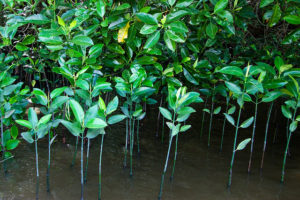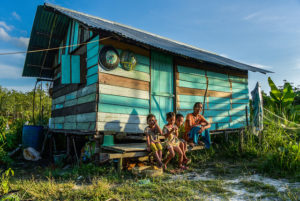
COP23 special: A diverse group moves from local to global in the fight against deforestation and climate change.
Promising to stop cutting down forests is one thing. Actually doing it is another.
At the recent Governors’ Climate and Forests (GCF) Task Force Annual Meeting in Balikpapan, Indonesia, representatives hailing from disparate parts of the world – and mostly tropical states – met to discuss just how to do that. There they launched the Balikpapan Statement, which focuses on sustainable supply chains, the rights and livelihoods of indigenous communities and long-term financing.
At the COP23 in Bonn, Earth Innovation Institute (EII), the GCF Task Force and partners will hold a series of events to further the commitments made in Balikpapan.
“The GCF Task Force is an innovative global partnership of states and provinces that’s been working for nearly nine years. It’s now up to 38 members and growing. Its purpose is pretty simple and big: helping subnational governments in the tropics shift to forest-maintaining, sustainable development,” said EII Executive Director Daniel Nepstad.
Read more: FTA at COP23
With one focus on implementing the Reducing Emissions from Deforestation and Forest Degradation (REDD+) international framework at the subnational level, the discussions are integral pieces in the puzzle of global climate action exemplified by COP23.
Center for International Forestry Research (CIFOR) scientist Stibniati Atmadja, whose work focuses on provincial-level REDD+, said at the GCF Annual Meeting, “These kinds of fora are important to get the message across about what states are doing to contribute to climate change mitigation, especially that states are committing to these activities based on forestry and that they have important lessons that others can learn.”
“At the international level in negotiating at the UNFCCC, these messages are very important,” she added.
With COP23 in Bonn from 6-17 November including a swath of climate discussions from the local and provincial to national, regional and global levels, it is essential that people understand what is happening on the ground in diverse states, in tropical forests, in muddy peat and in tangled mangroves.
WET AND WILD

“I work in a number of provinces like West Papua, East Kalimantan and West Kalimantan that have a lot of potential to be part of climate solutions as far as wetlands are concerned. But wetlands and their role in climate mitigation is not on the radar of many governments, nor are the benefits to keeping them intact and protecting them,” CIFOR scientist Daniel Murdiyarso said at the Balikpapan meeting.
At the Indonesia Pavilion at COP23, CIFOR and Indonesia’s Peatland Restoration Agency (BRG) will host a discussion on the collective action required to restore these spaces, which have an integral role to play as carbon sinks and as part of the country’s commitment to reducing emissions.
“The Mahakam Delta wetlands in East Kalimantan are one area with carbon-rich mangroves, but they are facing tremendous pressure from the expansion of shrimp ponds,” Murdiyarso said.
He added, “How the region will manage and govern such assets is key. The actions to be taken by the Forest Management Unit is worth the attention to take a closer look.”
Read more: An explanation of Green Climate Fund payments
TRANSFORMATIONAL
Governance and solving the climate issue go hand-in-hand, and one-third of the world’s tropical forests are in GCF Task Force states and provinces, including more than three-fourths of Brazil’s and Peru’s and more than half of Indonesia’s.
As CIFOR scientist Amy Duchelle said on the sidelines of the GCF Task Force meeting about one of the member states where she has conducted research for many years, “If we think about transformational change, the case of Acre in Brazil with its State System of Incentives for Environmental Services is an interesting example. It entailed a governance structure change that brought together many different kinds of policies under one umbrella towards forest-based development.”
At COP23, CIFOR’s side event will look at just such examples of change and what gaps remain in the battles to reduce emissions and halt deforestation, including reflections from a subnational government representative.
Duchelle said, “We are starting a new collaboration with the GCF Task Force, EII and the Climate, Community and Biodiversity Alliance to assess the progress of jurisdictions towards low emissions rural development. One big research question now is ‘What are the enabling conditions, and key policies and interventions, that can lead to positive environmental and socioeconomic outcomes on the ground?’”

BOTTOMS UP
In opening remarks at the GCF Task Force meeting, Governor Awang Faroek of East Kalimantan said, “Through these discussions, we hope to come to a consensus in how to best establish realistic strategies in order to realize development that is not only environmentally sustainable, but also socially inclusive.”
This realism stems from seeing things clearly on the ground. At the meeting in Balikpapan, emphasis was placed on the need for successful local processes, with GCF Task Force chair William Boyd saying, “This is what bottom-up climate governance looks like,” as he scanned a room of representatives from across the world that included indigenous leaders, governors and civil society heads.
Read more: Sharing better, for better research
On such governance, Mudiyarso said, “Bottom-up processes are very important because the agenda is clear, but we also need to understand the top-down process and find a meeting point. Local governments need to be informed about what’s going on at the national level, and the national-level government also has to be very accommodating with the specifity at the provinces.”
He suggested one necessary meeting space between such processes could be financing, with Atmadja in agreement.
“REDD+ is seen as a way to fund what provinces want to do. For example, from my interviews in Aceh, in general they’re saying REDD+ is a great opportunity to fund our green vision,” she said.
She added, “I think this kind of viewpoint is very sustainable because REDD+ is here now and ten years from now it may evolve into something else. But if it supports objectives that come from within, then it’s even more sustainable.”
At COP23 in Bonn, such intersecting, transnational discussions continue, all with aim of change both big and small.
By Deanna Ramsay, originally published at CIFOR’s Forests News.
This research forms part of the CGIAR Research Program on Forests, Trees and Agroforestry, which is supported by CGIAR Fund Donors.
This research was supported by UK aid from the UK government.











